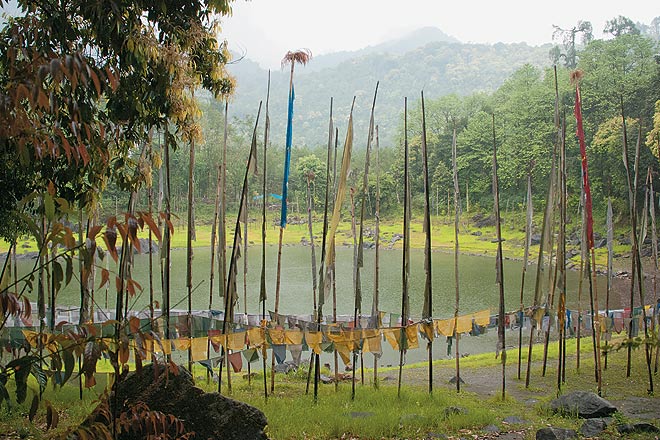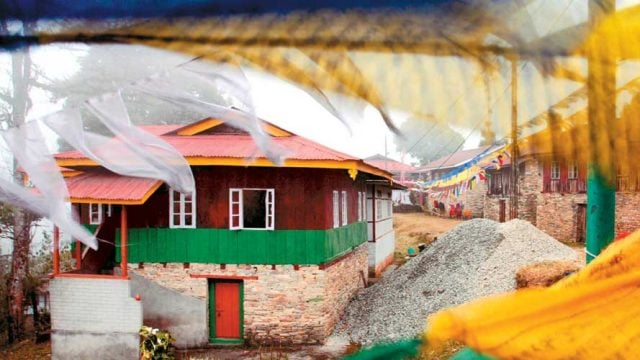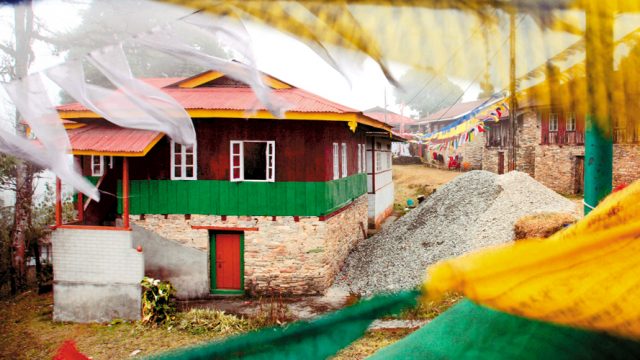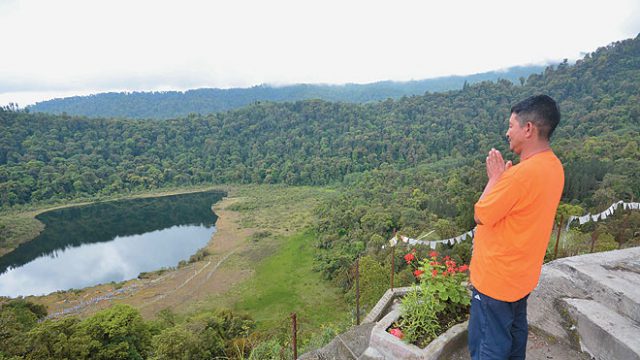These Bengali tourists are so noisy,” my host Sonam Yungda Bhutia said good-humouredly,
My colleague Sujatha Padmanabhan and I were at Khecheopalri Lake, one of western Sikkim’s wetland jewels. Set amidst densely forested hills, the lake is ecologically important, and being sacred to Buddhists and Hindus, has remained strictly off limits for human use other than pilgrimage and visits. It was originally called Kha-Chod-Palri (‘wish-fulfilling jewel’). From one lookout point high above the lake, its shape appears to be that of a footprint, and local Buddhist belief is that this is where the goddess Tara Jetsun Dolma (the Buddha’s mother) stepped; the Hindus believe it is Shiva’s footprint. Scientists, somewhat more mundanely, say that the lake is a result of ancient glacial action. Whatever the origin, the lake’s great cultural significance is borne out by the hundreds of prayer flags lining its banks and walkways, the various taboos and beliefs attached to it, the dozen or more folklore and mythological tales explaining its origins…and the quiet resentment towards badly behaved tourists who desecrate its surrounds.

Khecheopalri is surrounded by about 500 hectares of broad-leaved forests. Technically of a mixed temperate kind, they have high plant diversity and include oak, rhododendron, walnut, champa, avocado, cinnamon, alder, pine, orchids and bamboo. As we made our way through the dense groves, a green-tailed sunbird and a grey-headed canary flycatcher dazzled us with their acrobatics, a Himalayan striped squirrel chattered its accompaniment to our ascent, and the bigger hoary-bellied squirrel peered at us through bamboo thicket. Sonam told us the surrounding forests have quite a lot of wildlife, and he has managed to convince most of the village to stop hunting.
Of mammal species, there are reportedly Himalayan black bears, yellow-throated martens, porcupines, flying squirrels and pangolins; of birds, there are kaleej pheasants, jungle fowls, several species of laughing thrushes and shrike-babblers, and several dozen other species. The village contributes to conserving these forests. Traditionally, this was done through a village mandal consisting of elders, and now it is the function of a joint forest management committee set up with the forest department.

Not all the 10,000 visitors who come annually to Khecheopalri know that it is also a wish-fulfilling lake, so they probably miss the chance to have their dreams come true. These visitors are hard to manage, don’t necessarily follow rules regarding noise and garbage dumping, and can get into petty fights even to pay the nominal entrance fee, but they also bring in much-needed revenue to the village. The money is used to employ the four persons responsible for managing entry, cleaning the surrounds, and guarding the lake; it is also used to improve the approach path, install garbage bins and provide other such facilities. Tired of waiting for the government to repair a crumbling bridge that takes visitors over a marsh to the lakeside, the village has also used the funds to make a new, safe bridge.
Though deterred by the jostling crowd on the bridge, we took off our shoes and walked onto it. At the edge of the lake, we were greeted with the bizarre sight of dozens of big, red fish crowding the shore. Gyamtso Bhutia, a lake guard, told us this happens because people threw crumbs to the fish when he was not around, even though it is prohibited. The noise created by tourists (one boy was asking his mother why Holi couldn’t be played there, having been just told that it was a holy lake) was truly disturbing, and we beat a hasty retreat. We plunged into the forest on the other side and made our way up a steep slope to a newly constructed lookout shed a few hundred metres above the lake. When we emerged at the top, lungs bursting with the effort, and looked down, all tiredness was forgotten in an instant. Lying snug within lush green forests on all sides, the lake shone like an emerald — it was easy to understand why it would evoke a feeling of spiritual respect and awe. A serpent eagle circled lazily over the lake, its sharp eyes scouring the banks for prey, its occasionally high-pitched triple-cry breaking the stillness.

The lake itself, with depths ranging from two to eleven metres, has a diversity of aquatic life. This includes several dozen species of macrophytes (plants growing in or near water), phytoplankton and zooplankton (microscopic plants and animals), and fish species such as the Cyprinus carpio (common carp) and Danio aequipinnatus (or giant danio), and species of Garra, Schistura and Schziothorax. Such diversity is indicative of a healthy lake (though some of the fish were introduced). In the distance, at the far end of the lake, we saw an almost totally white water bird and excitedly realised it was a goosander — not a common bird in other parts of India. The region is an important wintering area for migratory birds, or resting spot for resident species, including the bar-headed goose, the ruddy shelduck, Baer’s pochard, black-necked grebe, merganser, tufted duck, teals, and the rare black-tailed crake. There is even one record of a black-necked crane, which is counted among India’s most threatened species. Khecheopalri is considered important enough for NGOs like the World Wildlife Fund and the Salim Ali Centre for Ornithology and Natural History to recommend its inclusion in the Ramsar list of wetlands of international importance.

Run-off from the lake also provides important ecological and social benefits. Somewhere below the plateau on which the lake sits, the water cascades through the Khangchendzonga waterfall, a major tourist destination. One can spy white-capped and plumbeous redstarts, forktails, dippers and other birds along the stream below the falls.
Noticing a large area of what appeared to be barren ground along the lake, before the forested slopes started, I asked Sonam whether the water rose and fell seasonally. He said the seasonal difference was marginal, but that he felt the water spread was decreasing over the last few years. What looked like hard ground was, in fact, marsh or bog. According to the Forest Department, the lake is spread over about 3.8 hectares and there is another seven hectares of bog — the surrounding watershed area is about 1,200 hectares and includes forests, farms and rocky outcrops. Some studies suggest that inappropriate agricultural use and expansion of settlements in the catchment areas has increased sediment inflow, resulting in the shrinkage of Khecheopalri from what is believed to be at least twice its current size a few decades back.
Perched high above the lake, we got a lowdown from Sonam about what the local village is doing for the water body. In 2007, a Khecheopalri Pokhri Sanrakshan Samiti (KPSS) was established with help from the district administration and the forest department. Its 14 members are from the local panchayat and active residents. The Samiti’s main functions are to protect the lake and surrounds, and control waste. It employs two local youth, Chungku Lepcha and Migma Lepcha, to collect entry fees. Half of this revenue is used for carrying out its functions, and half goes to the Forest Department. KPSS has also helped to build toilets and provide cushions for nearby monasteries and nunneries. The KPSS garbage in-charge, Nam Tshering Lepcha, told us that they had held sessions on waste management with the regular cab drivers who brought tourists (this included putting a bamboo basket in each vehicle so that passengers wouldn’t throw rubbish out of the window). The Khangchendzonga Conservation Committee, a group of youth in Yuksom who have pioneered ecologically responsible tourism, was part of the process to set up the KPSS, and has trained villagers on garbage management, visitor guidance and spreading environmental awareness.
Khecheopalri faces major challenges, including an increasing number of tourists (on peak days there are even traffic jams at the entrance!), shrinkage of the water spread, replacement of forests by farms in the catchment areas, and pollution from the surrounding settlements. KPSS members are hopeful that the local community, conservation groups and relevant government departments will collaborate to tackle these threats. Such concerted action is crucial if the sanctity, beauty, and value of the lake are to be secured for future generations.
The Information
Getting there
The lake is located near the Khecheopalri village, which is 147km west of Gangtok, and 34km northwest of Pelling in West Sikkim district. The nearest airport is at Bagdogra (165km) and the nearest railway station is New Jalpaiguri (162km), both in West Bengal. Entry to the lake complex is by ticket, the receipts from which go towards the maintainance of the lake.
Where to stay
Khecheopalri village has lodging, trekkers’ huts, and some homestay facilities. Most visitors come on a day’s visit from Pelling or Yuksom (26km).
What to see & do
Learn local culture, trek in the surrounding forests, and visit nearby monasteries. Roadside eateries sell noodles, momos and rice. A large fair to honour the lake deity is held in February-March, coinciding with the 15th day of the first month of the Tibetan calendar. The Kangchendzonga waterfall, 15km from Khecheopalri, is also worth visiting. Yuksom is the gateway to the Kangchendzonga National Park, one of Sikkim’s best wildlife regions and trekking routes. It’s the original capital of the state, venue of the first king’s coronation, and home to Dubdi, Sikkim’s oldest monastery. It’s a picturesque setting and offers lovely homestays. For a visit to the national park and other trekking, wildlife-watching and adventure options, contact the Khangchendzonga Conservation Committee by calling Pema Bhutia (9735095543) or Kinzong Bhutia (9733158268) or email [email protected]. An entry fee to the lake is charged by the Khecheopalri Pokhri Sanrakshan Samiti. Panchayat president Yongda Bhutia (9733098395) owns a lodge and a restaurant.
Sikkim
Leave a Reply
You must be logged in to post a comment.





